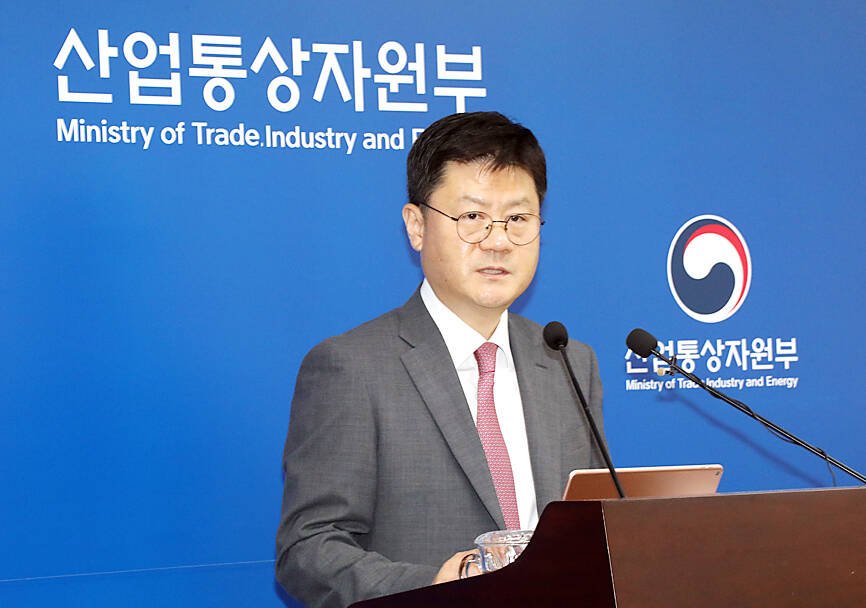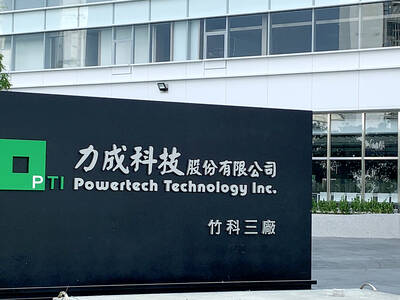South Korea’s export growth accelerated last month, reflecting resilience in global demand, as the artificial intelligence and technology sectors drive record gains in semiconductor sales.
Average daily shipments increased 12.4 percent from a year earlier, data released yesterday by Korea Customs Service showed, compared with 9 percent growth in May.
Headline exports, which do not reflect differences in the number of working days in the reporting month, rose 5.1 percent to US$57.07 billion, while overall imports fell 7.5 percent to US$49.07 billion. That resulted in a trade surplus of US$8 billion, the biggest since 2020.

Photo: EPA-EFE/Yonhap
The value of semiconductor shipments amounted to US$13.4 billion, soaring 51 percent from a year earlier last month, the South Korean Ministry of Trade, Industry and Energy said in a statement.
Display products rose 26 percent and exports of computers increased 59 percent from a year earlier, while the sales of wireless communications devices advanced 3.9 percent, the ministry said.
Demand from the US led the gains in exports, with shipments to the world’s largest economy rising 14.7 percent from a year earlier to US$11.02 billion last month, while sales to China increased 1.8 percent to US$10.7 billion, marking a fourth month of growth.
South Korea’s largest trade surplus since September 2020 supports the view that the economy might grow more than previously forecast this year.
It also suggests that the weakening of the local currency is forcing importers to cut back on purchases from abroad, Korea International Trade Association analysis and forecasts director Austin Chang said.
In a separate survey released yesterday by the Federation of Korean Industries, South Korean firms said stability in the foreign exchange market ranks as the most important policy objective from their perspective.
They see 1,332 as the preferred level for the won against the US dollar, the survey showed.
The won was about 1,378 against the US currency mid-morning yesterday.
Almost two-thirds of major South Korean companies in the survey said they expect exports to keep rising in the second half of this year.
Separate data released yesterday also pointed to continued strength in the factory sector, as S&P Global’s manufacturing purchasing managers index rose from 51.6 in May to 52 last month, its highest since April 2022.
While the outlook for exports remains bright, South Korea might face the risk of cheaper goods from China if the world’s largest manufacturing country floods the market with them to ride out its economic trouble, Chang said.
Meanwhile, South Korean businesses might also have to grapple with stronger trade protectionism and fewer tax incentives in the US in the longer term, should former US president Donald Trump retake the White House in November elections, he added.

RUN IT BACK: A succesful first project working with hyperscalers to design chips encouraged MediaTek to start a second project, aiming to hit stride in 2028 MediaTek Inc (聯發科), the world’s biggest smartphone chip supplier, yesterday said it is engaging a second hyperscaler to help design artificial intelligence (AI) accelerators used in data centers following a similar project expected to generate revenue streams soon. The first AI accelerator project is to bring in US$1 billion revenue next year and several billion US dollars more in 2027, MediaTek chief executive officer Rick Tsai (蔡力行) told a virtual investor conference yesterday. The second AI accelerator project is expected to contribute to revenue beginning in 2028, Tsai said. MediaTek yesterday raised its revenue forecast for the global AI accelerator used

Taiwan Semiconductor Manufacturing Co (TSMC, 台積電) has secured three construction permits for its plan to build a state-of-the-art A14 wafer fab in Taichung, and is likely to start construction soon, the Central Taiwan Science Park Bureau said yesterday. Speaking with CNA, Wang Chun-chieh (王俊傑), deputy director general of the science park bureau, said the world’s largest contract chipmaker has received three construction permits — one to build a fab to roll out sophisticated chips, another to build a central utility plant to provide water and electricity for the facility and the other to build three office buildings. With the three permits, TSMC

The DBS Foundation yesterday announced the launch of two flagship programs, “Silver Motion” and “Happier Caregiver, Healthier Seniors,” in partnership with CCILU Ltd, Hondao Senior Citizens’ Welfare Foundation and the Garden of Hope Foundation to help Taiwan face the challenges of a rapidly aging population. The foundation said it would invest S$4.91 million (US$3.8 million) over three years to foster inclusion and resilience in an aging society. “Aging may bring challenges, but it also brings opportunities. With many Asian markets rapidly becoming super-aged, the DBS Foundation is working with a regional ecosystem of like-minded partners across the private, public and people sectors

BREAKTHROUGH TECH: Powertech expects its fan-out PLP system to become mainstream, saying it can offer three-times greater production throughput Chip packaging service provider Powertech Technology Inc (力成科技) plans to more than double its capital expenditures next year to more than NT$40 billion (US$1.31 billion) as demand for its new panel-level packaging (PLP) technology, primarily used in chips for artificial intelligence (AI) applications, has greatly exceeded what it can supply. A significant portion of the budget, about US$1 billion, would be earmarked for fan-out PLP technology, Powertech told investors yesterday. Its heavy investment in fan-out PLP technology over the past 10 years is expected to bear fruit in 2027 after the technology enters volume production, it said, adding that the tech would